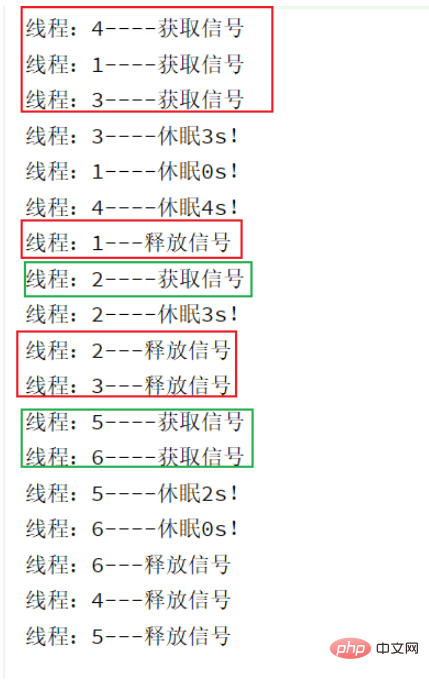 Java
Java
 javaTutorial
javaTutorial
 To implement signal synchronization in Java multi-threaded collaborative jobs, you can use the following methods:
To implement signal synchronization in Java multi-threaded collaborative jobs, you can use the following methods:
To implement signal synchronization in Java multi-threaded collaborative jobs, you can use the following methods:
1. Signal synchronization
Multiple threads are often collaborative operations. For example, four threads collect statistics on e-commerce data quarterly. After the statistics are completed, they are summarized. How to know that all four threads have been executed? We can use the auxiliary classes CountDownLatch (
reduce count), CyclicBarrier (cyclic barrier), and Semaphore (semaphore) provided to us by JDK1.5.
2. Based on the time dimension
1. CountDownLatch
The construction parameters of CountDownLatch are initialized according to the number of cooperating threads.
public static void main(String[] args) throws InterruptedException {
final int NUM=6;
//定义总数量;
CountDownLatch countDownLatch=new CountDownLatch(NUM);
for (int i = 0; i < NUM; i++) {
new Thread(()->{
System.out.println(Thread.currentThread().getName()+"线程,已执行!");
//减少计数
countDownLatch.countDown();
},String.valueOf(i+1)).start();
}
//等待所有任务完成
countDownLatch.await();
System.out.println("所有线程任务已经执行完成!");
}
2. CyclicBarrier
is similar to reducing count
public static void main(String[] args) {
final int NUM = 6;
//定义循环数量及循环完成后的任务(Runnable接口实现);
CyclicBarrier cyclicBarrier = new CyclicBarrier(NUM, () -> {
System.out.println("所有线程任务已经执行完成!");
});
for (int i = 0; i < NUM; i++) {
new Thread(()->{
System.out.println(Thread.currentThread().getName()+"线程,已执行!");
try {
//等待点或障碍点,等待所有任务完成,
cyclicBarrier.await();
} catch (InterruptedException e) {
e.printStackTrace();
} catch (BrokenBarrierException e) {
e.printStackTrace();
}
},String.valueOf(i+1)).start();
}
}
import java.util.Random;
import java.util.concurrent.Semaphore;
import java.util.concurrent.TimeUnit;
/*信号灯
* 6个线程,抢占三个信号
* */
public class SemaphoreDemo {
public static void main(String[] args) {
Semaphore semaphore=new Semaphore(3);
for (int i = 0; i < 6; i++) {
new Thread(()->{
try {
//获取信号
semaphore.acquire();
System.out.println("线程:"+Thread.currentThread().getName()+"----获取信号");
int time = new Random().nextInt(5);
System.out.println(("线程:"+Thread.currentThread().getName()+"----休眠"+time+"s!"));
TimeUnit.SECONDS.sleep(time);
} catch (InterruptedException e) {
e.printStackTrace();
}finally {
// 释放信号
System.out.println("线程:"+Thread.currentThread().getName()+"---释放信号");
semaphore.release();
}
},String.valueOf(i+1)).start();
}
}
}
The above is the detailed content of To implement signal synchronization in Java multi-threaded collaborative jobs, you can use the following methods:. For more information, please follow other related articles on the PHP Chinese website!

Hot AI Tools

Undresser.AI Undress
AI-powered app for creating realistic nude photos

AI Clothes Remover
Online AI tool for removing clothes from photos.

Undress AI Tool
Undress images for free

Clothoff.io
AI clothes remover

Video Face Swap
Swap faces in any video effortlessly with our completely free AI face swap tool!

Hot Article

Hot Tools

Notepad++7.3.1
Easy-to-use and free code editor

SublimeText3 Chinese version
Chinese version, very easy to use

Zend Studio 13.0.1
Powerful PHP integrated development environment

Dreamweaver CS6
Visual web development tools

SublimeText3 Mac version
God-level code editing software (SublimeText3)

Hot Topics
 1392
1392
 52
52
 36
36
 110
110
 Perfect Number in Java
Aug 30, 2024 pm 04:28 PM
Perfect Number in Java
Aug 30, 2024 pm 04:28 PM
Guide to Perfect Number in Java. Here we discuss the Definition, How to check Perfect number in Java?, examples with code implementation.
 Weka in Java
Aug 30, 2024 pm 04:28 PM
Weka in Java
Aug 30, 2024 pm 04:28 PM
Guide to Weka in Java. Here we discuss the Introduction, how to use weka java, the type of platform, and advantages with examples.
 Smith Number in Java
Aug 30, 2024 pm 04:28 PM
Smith Number in Java
Aug 30, 2024 pm 04:28 PM
Guide to Smith Number in Java. Here we discuss the Definition, How to check smith number in Java? example with code implementation.
 Java Spring Interview Questions
Aug 30, 2024 pm 04:29 PM
Java Spring Interview Questions
Aug 30, 2024 pm 04:29 PM
In this article, we have kept the most asked Java Spring Interview Questions with their detailed answers. So that you can crack the interview.
 Break or return from Java 8 stream forEach?
Feb 07, 2025 pm 12:09 PM
Break or return from Java 8 stream forEach?
Feb 07, 2025 pm 12:09 PM
Java 8 introduces the Stream API, providing a powerful and expressive way to process data collections. However, a common question when using Stream is: How to break or return from a forEach operation? Traditional loops allow for early interruption or return, but Stream's forEach method does not directly support this method. This article will explain the reasons and explore alternative methods for implementing premature termination in Stream processing systems. Further reading: Java Stream API improvements Understand Stream forEach The forEach method is a terminal operation that performs one operation on each element in the Stream. Its design intention is
 TimeStamp to Date in Java
Aug 30, 2024 pm 04:28 PM
TimeStamp to Date in Java
Aug 30, 2024 pm 04:28 PM
Guide to TimeStamp to Date in Java. Here we also discuss the introduction and how to convert timestamp to date in java along with examples.
 Java Program to Find the Volume of Capsule
Feb 07, 2025 am 11:37 AM
Java Program to Find the Volume of Capsule
Feb 07, 2025 am 11:37 AM
Capsules are three-dimensional geometric figures, composed of a cylinder and a hemisphere at both ends. The volume of the capsule can be calculated by adding the volume of the cylinder and the volume of the hemisphere at both ends. This tutorial will discuss how to calculate the volume of a given capsule in Java using different methods. Capsule volume formula The formula for capsule volume is as follows: Capsule volume = Cylindrical volume Volume Two hemisphere volume in, r: The radius of the hemisphere. h: The height of the cylinder (excluding the hemisphere). Example 1 enter Radius = 5 units Height = 10 units Output Volume = 1570.8 cubic units explain Calculate volume using formula: Volume = π × r2 × h (4
 Create the Future: Java Programming for Absolute Beginners
Oct 13, 2024 pm 01:32 PM
Create the Future: Java Programming for Absolute Beginners
Oct 13, 2024 pm 01:32 PM
Java is a popular programming language that can be learned by both beginners and experienced developers. This tutorial starts with basic concepts and progresses through advanced topics. After installing the Java Development Kit, you can practice programming by creating a simple "Hello, World!" program. After you understand the code, use the command prompt to compile and run the program, and "Hello, World!" will be output on the console. Learning Java starts your programming journey, and as your mastery deepens, you can create more complex applications.



